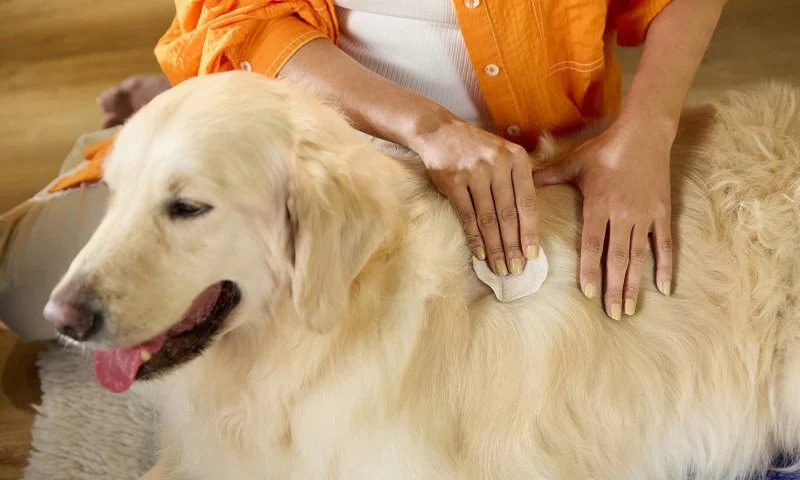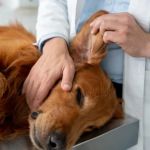
Skin Hot Spots on Dogs: Causes, Treatment & Home Care
Skin hot spots on dogs can be a common yet concerning issue for pet owners. These painful, inflamed areas of the skin often develop rapidly, causing your furry friend discomfort and distress. Understanding the causes of hot spots, how to treat them, and how to care for them at home can help you provide better care for your dog and prevent future flare-ups.
- 1. What Are Hot Spots on Dogs?
- 2. Causes of Hot Spots on Dogs
- 3. Treating Hot Spots on Dogs
- 4. Home Care for Dogs with Hot Spots
- 5. Find Pet Supplies at Pet & Puppy
1. What Are Hot Spots on Dogs?
Hot spots, also known as acute moist dermatitis, are areas of inflamed and infected skin that develop quickly on a dog’s body. These spots are typically caused by excessive scratching, biting, or licking of the skin, leading to irritation and open wounds. Hot spots are often red, moist, and painful, and they can become larger if not addressed promptly.

Hartland Park Animal Hospital
LexingtonFayette CountyKentucky
4750 Hartland Pkwy #170, Lexington, KY 40515, USA
Symptoms of Hot Spots
The symptoms of hot spots on dogs can vary, but common signs include:
- Red, inflamed patches of skin
- Excessive licking, biting, or scratching of the area
- Moist, oozing spots that may emit a foul odor
- Hair loss around the affected area
If you notice any of these signs, it’s important to take action quickly to prevent the condition from worsening.

The Pet Wellness Group: Hebron
1990 N Bend Rd Suite A, Hebron, KY 41048, USA
2. Causes of Hot Spots on Dogs
Hot spots can be caused by a variety of factors, often stemming from underlying skin irritation or allergies. Some common causes include:
Allergies
Dogs that suffer from environmental or food allergies may be more prone to developing hot spots. Allergies can lead to itchiness and skin inflammation, which encourages dogs to scratch or lick excessively.
Fleas and Other Parasites
Fleas, ticks, and other parasites can trigger hot spots. These pests cause itching and discomfort, prompting dogs to scratch or bite at their skin, leading to hot spot formation.
Moisture and Humidity
Moisture trapped in your dog’s fur, especially in hot, humid environments, can cause hot spots. This is common in dogs with thick coats or those who are frequently exposed to water.
Underlying Health Issues
Sometimes, hot spots can be a sign of other health problems such as infections, autoimmune diseases, or hormonal imbalances. It’s important to rule out these conditions when treating a hot spot.
3. Treating Hot Spots on Dogs
Prompt treatment is essential to prevent hot spots from worsening and causing further discomfort. Here are the steps to treat hot spots effectively:
Clean the Affected Area
Gently clean the hot spot with a mild antiseptic solution or warm water to remove any dirt, bacteria, or debris. Be sure to avoid harsh chemicals that may irritate the skin further.
Trim the Fur Around the Hot Spot
If possible, trim the fur around the hot spot to prevent further friction and allow the skin to dry properly. This also helps prevent the area from becoming more infected.
Apply Topical Treatments
After cleaning the area, apply a topical treatment such as an antiseptic spray or cream. There are also special ointments formulated to help with hot spots and speed up the healing process. Consult your veterinarian for the best options.
Prevent Licking and Biting
Prevent your dog from licking or biting the affected area by using an Elizabethan collar (cone) or a protective garment. This will allow the area to heal without interference from your dog’s own actions.
4. Home Care for Dogs with Hot Spots
In addition to veterinary care, there are several home care tips you can follow to help your dog recover from hot spots:
Keep the Area Dry
Moisture can worsen hot spots, so it’s important to keep the affected area dry. Use a soft, absorbent towel to blot the area dry after your dog gets wet, and avoid bathing them too frequently.
Monitor for Signs of Infection
Watch for signs of infection, such as increased redness, pus, or foul-smelling discharge. If you notice these symptoms, contact your veterinarian for further treatment.
Provide a Comfortable Environment
Ensure that your dog has a clean and comfortable environment to rest in while recovering. Limit outdoor activities that could expose the hot spot to further irritation, and keep your dog indoors during the healing process if needed.
5. Find Pet Supplies at Pet & Puppy
If your dog is dealing with hot spots, having the right supplies on hand is essential. At Pet & Puppy, you can find a variety of products to help with treating hot spots, including antiseptic sprays, soothing creams, and protective collars. Explore our range of pet care products to help your dog feel comfortable and recover quickly.
By understanding the causes of hot spots and providing the right treatment, you can help your dog recover quickly and prevent future flare-ups. Regular care and attention to your dog’s skin health are key to ensuring they stay comfortable and happy.







 Nitrogen Aquatics0.0 (0 reviews)
Nitrogen Aquatics0.0 (0 reviews) Fuchs Joyce DVM4.0 (15 reviews)
Fuchs Joyce DVM4.0 (15 reviews) Eastpoint Veterinary Clinic4.0 (118 reviews)
Eastpoint Veterinary Clinic4.0 (118 reviews) DownHome Veterinary Clinic, LLC4.0 (221 reviews)
DownHome Veterinary Clinic, LLC4.0 (221 reviews) PetVet Vaccination Clinic5.0 (1 reviews)
PetVet Vaccination Clinic5.0 (1 reviews) Bright Veterinary Clinic4.0 (363 reviews)
Bright Veterinary Clinic4.0 (363 reviews) How to Detect & Manage Pet Ear Tumors: Signs, Treatment & Care
How to Detect & Manage Pet Ear Tumors: Signs, Treatment & Care How to Build a Pet Emergency Kit: Essentials You Need
How to Build a Pet Emergency Kit: Essentials You Need How to Vet a New Pet Food Brand: 10 Warning Flags
How to Vet a New Pet Food Brand: 10 Warning Flags How to Read the “Guaranteed Analysis” on Pet Food Labels
How to Read the “Guaranteed Analysis” on Pet Food Labels Transitioning Training Methods as Pet Ages: Adapting Techniques for Senior Pets
Transitioning Training Methods as Pet Ages: Adapting Techniques for Senior Pets Recognizing Pet Anxiety: Behavioral & Physiological Cues Every Pet Owner Should Know
Recognizing Pet Anxiety: Behavioral & Physiological Cues Every Pet Owner Should Know